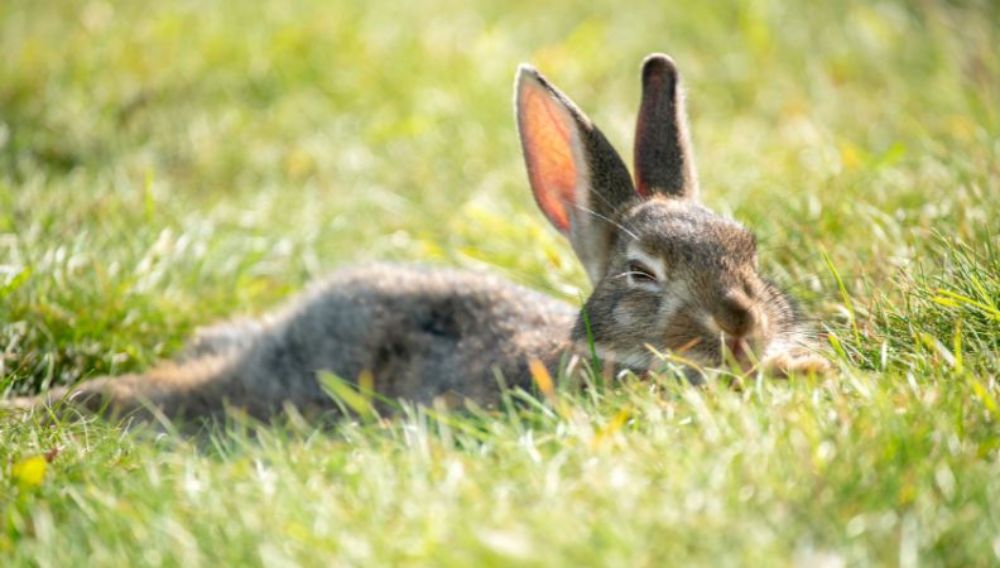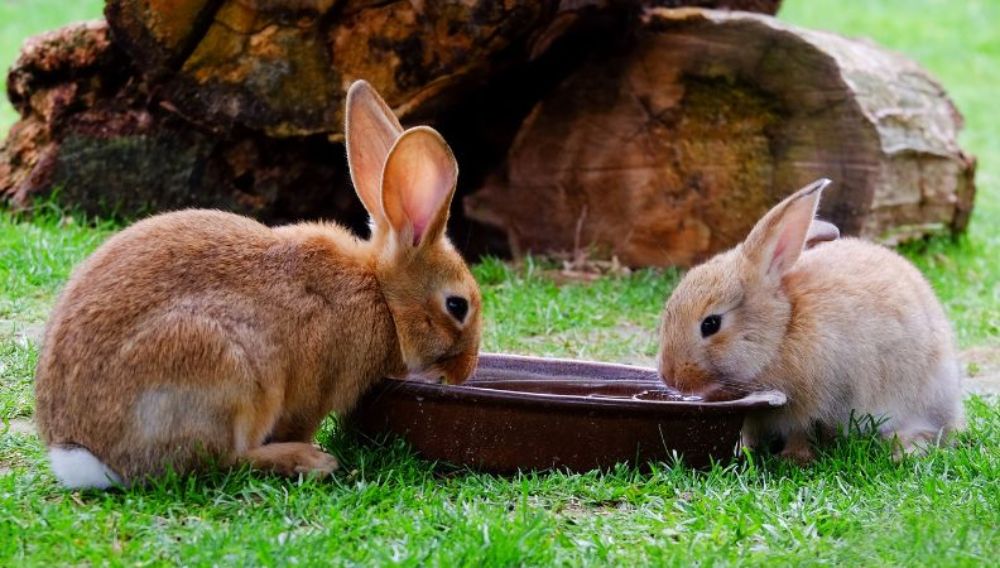
The optimum environmental temperature for a rabbit is 15-20°C (59-68°F). They can withstand colder temperatures if given enough protection and bedding, but too much heat can lead to serious problems.
Rabbits have thick fur coats which provides excellent insulation in winter but becomes a disadvantage in the summer. Normally, a rabbit’s body temperature is around 38.5-40°C (101-104°F), anything above 40 degrees is dangerous for a bunny.
Many bunnies like to sunbathe and there are health benefits to being exposed to sunlight, but keeping cool isn’t easy for them. Unlike some other animals, rabbits don't have the ability to sweat or pant effectively. So when it comes to a summer streak of hot weather or even a random hot day, your bunny needs help to keep cool. Our expert guide is here to give you the tips you need, and how you can spot the signs your bunny may be too hot.
How to Cool a Rabbit Down in Summer
During the summer months, your rabbit is going to need your help to stay cool. Knowing how to keep rabbits coolin the summer can help them to stay comfortable on hot days. Their main way of regulating their body temperature is losing heat through their ears, which have a large surface area and a thinner layer of fur, this means any excess heat can escape quicker.
A rabbit’s ears are very important when it comes to keeping cool but what can you do to keep your rabbit cool in summer?
There's a few things you can do in the hot summer weather, even if your rabbit is an indoor or outdoor rabbit.
Can Pet Rabbits Stay Outside in Summer?
Yes, but you may need to make a few changes to help keep your rabbit cool. In the wild, rabbits avoid hot temperatures by staying below ground where it’s cooler and only come out at dawn and dusk when the temperature is lower.
Pet rabbits don’t tend to have burrows, so rely on their owners to provide areas for them to keep cool. Knowing how to keep outdoor rabbits cool in summer will help to prevent overheating and heatstroke.
Your rabbit’s hutch should be constantly positioned in the shade otherwise it will quickly heat up like an oven. If you don’t have a naturally shady spot in your garden, use a sunshade to gain the coverage you need. A rabbit will be much cooler outside in the shade than in their hutch, so give them lots of time in a shaded run or secure garden with plenty of shade.
Remember that the positioning of the sun will change throughout the day, so you’ll need to make sure there’s always some shade for them. You could also introduce some ceramic tiles or slate into their run for them to lie on, but make sure you keep them in the shade, or they will become very hot!
How to Keep a House Rabbit Cool in Summer
You may be wondering how to keep indoor rabbits cool in summer... house rabbits or those kept in large sheds will benefit from air conditioning or a fan on a low/medium setting. But make sure they’re not in a constant draught and that the fan’s electric cable is out of reach so that they can’t chew it!
You can also open windows to allow a breeze to flow through the house. Shut the curtains or blinds if the sun is coming directly through the window as this will help to keep the room cool too.
Whether kept indoors or outside, your rabbit will need constant access to plenty of fresh water – ideally in both a water bottle and bowl during the summer months. Your pet will also benefit from items like damp towels, a rabbit cooling mat, ice packs or frozen water bottles to lie against.
Brushing your rabbit regularly will help to get rid of any excess fur that’ll be making them hot and uncomfortable - this is helpful to all breeds but particularly long-haired rabbits.
Some rabbits are sun-worshipers, so may choose to lay in the sun a lot. If this is the case for your rabbit, make sure you check on them regularly and occasionally move them into the shade so they cool down.
What to Do if My Rabbit is Too Hot?
If you think your rabbit is too hot you should move them into the shade, lay them on a damp towel or place one over their body, and use a fan or the cool setting on a hair dryer. Try wetting their ears with cool (but not cold) water. You must NEVER place your rabbit in cold water as the shock could be fatal. Always ensure they have plenty of cool water to drink to help prevent dehydration.

Signs of Heatstroke in Rabbits
It's not easy to spot when something is wrong with a rabbit as they’re great at hiding their pain and discomfort. But no one knows your rabbit as well as you do and it’s likely you’ll notice changes in their behaviour.
Signs of heatstroke in rabbits include:
- Loss of appetite – although reduced appetite is common during the summer months
- Lethargy
- Floppiness
- Increased breathing rate
- Nibbling around the nose and mouth – often leading to a blood-tinged area
If your rabbit is displaying any of these signs and you suspect they have heatstroke, contact your vet immediately. You vet may advise trying to cool them down at home to avoid the stress of bringing them into the practice. If they don’t seem to be getting better, despite your efforts to cool them down, you’ll need to take them to see your vet for emergency treatment.
Your rabbit may need to be given fluids and steroid injections to save their life. Your vet will probably want to run tests to check for any damage to their internal organs, and they may need to stay in intensive care to make a full recovery.
Heatstroke is a very serious condition in rabbits that can be fatal, so make sure you speak to a vet if you’re concerned about your furry friend.
Do Rabbits Eat Less in Summer?
It’s very common for pet rabbits to eat less during the summer months, so you may need to switch to a more nutrient-dense feed. This will ensure they're getting the nutrition they need on a lower intake of food.
You may also be able to tempt them with some tasty DIY pet treats. Chop up their favourite fruit and veg and pop them in the freezer, or you can blend them up into a smoothie and then freeze them in ice cube trays. These treats will also help to keep them cool as well as increase their food intake. Washing leafy greens with cold water and leaving them slightly wet not only provides more water content but also makes the food more refreshing and appealing.
Keeping rabbits cool in summer is simple – provide them with shade, fresh water, fans, and cooling devices like damp towels. You should regularly groom your bunny, especially long-haired rabbits, to remove excess fur and help reduce the thickness of their coat. A decrease in appetite is normal but eating can be encouraged by offering chilled food. If your pet bunny displays signs of heatstroke, contact your vet immediately and try to cool them down by wetting their ears and using damp towels and a fan.
Everypaw Rabbit Insurance
Here at Everypaw, we want to help you keep your bunny healthy and in tip top shape. So, when it comes to your young rabbit’s care, Everypaw’s Rabbit Insurance could be just the cover to look after your little thumper.
Content provided from Vetstream's Vetlexicon Lapis – www.vetlexicon.com/treat/lapis
Vetlexicon is the world’s largest peer-reviewed online clinical reference source. All our content is written and peer-reviewed by over 1,000 of the world’s leading veterinarians, ensuring relevance, accuracy and quality.
- Vetstream Ltd & Speight C (online) Summer safety. In: Vetlexicon Lapis. Vetstream Ltd, UK. Website: https://www.vetlexicon.com/lapis/internal-medicine/client-factsheets/summer-safety
- Speight C & Purnell E (online) Keeping rabbits safe outside. In: Vetlexicon Lapis. Vetstream Ltd, UK. Website: https://www.vetlexicon.com/lapis/internal-medicine/client-factsheets/keeping-rabbits-safe-outside
- Thompson L, Flecknell P & Meredith A (online) Heat stroke. In: Vetlexicon Lapis. Vetstream Ltd, UK. Website: https://www.vetlexicon.com/lapis/cardiology/articles/heat-stroke